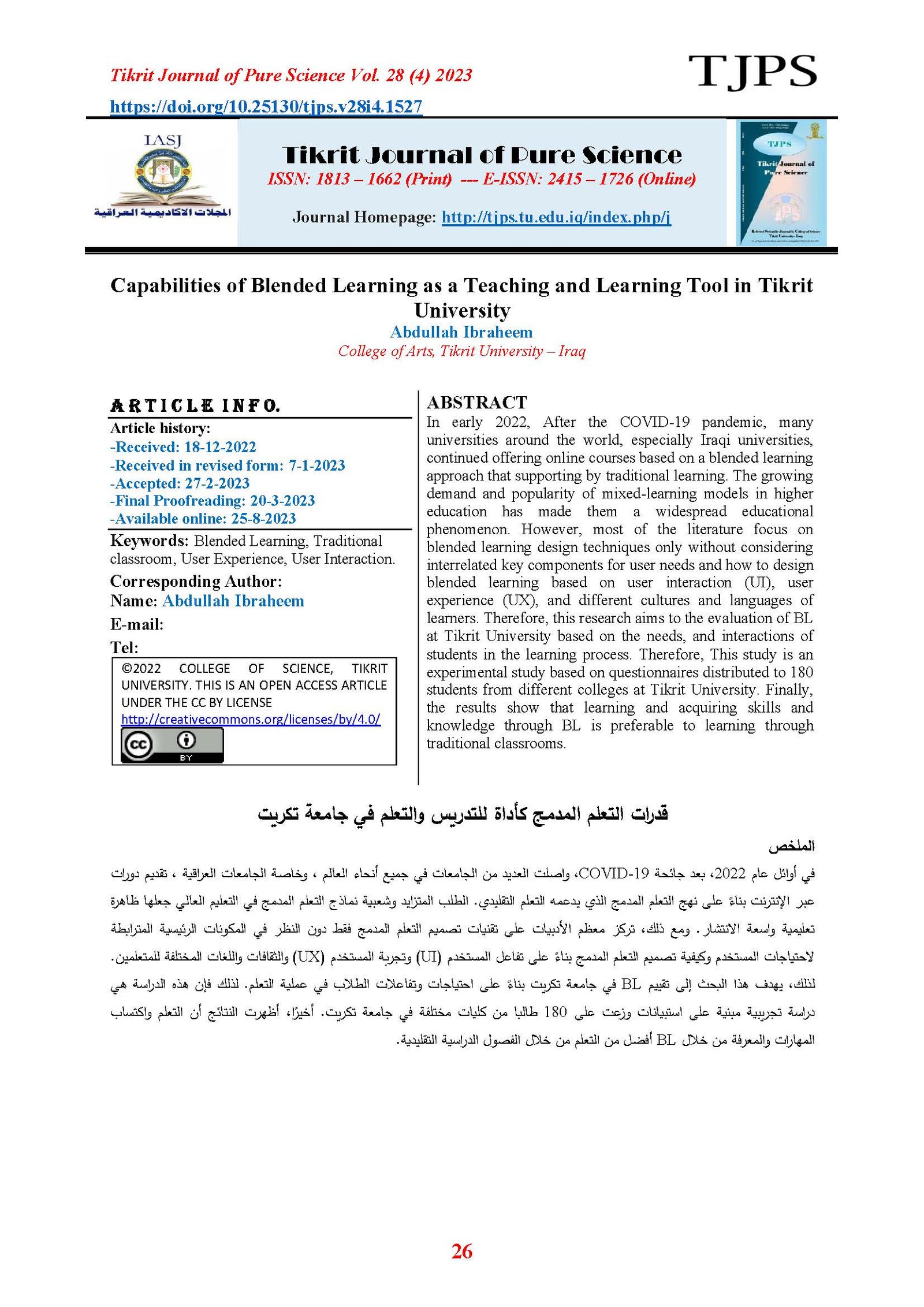Capabilities of Blended Learning as a Teaching and Learning Tool in Tikrit University
Main Article Content
Abstract
In early 2022, After the COVID-19 pandemic, many universities around the world, especially Iraqi universities, continued offering online courses based on a blended learning approach that supporting by traditional learning. The growing demand and popularity of mixed-learning models in higher education has made them a widespread educational phenomenon. However, most of the literature focus on blended learning design techniques only without considering interrelated key components for user needs and how to design blended learning based on user interaction (UI), user experience (UX), and different cultures and languages of learners. Therefore, this research aims to the evaluation of BL at Tikrit University based on the needs, and interactions of students in the learning process. Therefore, This study is an experimental study based on questionnaires distributed to 180 students from different colleges at Tikrit University. Finally, the results show that learning and acquiring skills and knowledge through BL is preferable to learning through traditional classrooms.
Article Details

This work is licensed under a Creative Commons Attribution 4.0 International License.
Tikrit Journal of Pure Science is licensed under the Creative Commons Attribution 4.0 International License, which allows users to copy, create extracts, abstracts, and new works from the article, alter and revise the article, and make commercial use of the article (including reuse and/or resale of the article by commercial entities), provided the user gives appropriate credit (with a link to the formal publication through the relevant DOI), provides a link to the license, indicates if changes were made, and the licensor is not represented as endorsing the use made of the work. The authors hold the copyright for their published work on the Tikrit J. Pure Sci. website, while Tikrit J. Pure Sci. is responsible for appreciate citation of their work, which is released under CC-BY-4.0, enabling the unrestricted use, distribution, and reproduction of an article in any medium, provided that the original work is properly cited.
References
[1] A. O. Ismail, A. K. Mahmood, and A. Abdelmaboud, "Factors Influencing Academic Performance of Students in Blended and Traditional Domains," International Journal of Emerging Technologies in Learning, vol. 13, 2018.
[2] ALI, Q.A.: ‘USER INTERACTION IN IRAQI BLENDED MASSIVE OPEN ONLINE COURSE MODEL’
[3] D. D. Prasetya, A. P. Wibawa, T. Hirashima, and Y. Hayashi, "Designing Rich Interactive Content for Blended Learning: A Case Study from Indonesia," Electronic
Journal of e-Learning, vol. 18, pp. pp276-286-pp276-286, 2020.
[4] M. Baldassarre, M. Dicorato, and I. Fiore, "Learning design of blended learning at university," in teleXbe, 2021.
[5] R. Owston, D. N. York, and T. Malhotra, "Blended learning in large enrolment courses: Student perceptions across four different instructional models," Australasian Journal of Educational Technology, vol. 35, pp. 29-45, 2019.
[6] N. Kholifah, P. Sudira, R. Rachmadtullah, M. Nurtanto, and S. Suyitno, "The effectiveness of using blended learning models against vocational education student learning motivation," International Journal, vol. 9, 2020.
[7] L. Di Marco, J. Breton, D. K. Martin, P. Morand, and P. Gillois, "Freedom of master's degree students to study in health curricula: Switching to optimized blended learning as a solution!," Yearbook of Medical Informatics, vol. 29, pp. 247-252, 2020.
[8] D. Keržič, N. Tomaževič, A. Aristovnik, and L. Umek, "Exploring critical factors of the perceived usefulness of blended learning for higher education students," PloS one, vol. 14, p. e0223767, 2019.
[9] Anthony Jnr, B.: ‘An exploratory study on academic staff perception towards blended learning in higher education’, Education and Information Technologies, 2022, 27, (3), pp. 3107-3133
[10] M. Zhu, S. Berri, and K. Zhang, "Effective instructional strategies and technology use in blended learning: A case study," Education and Information Technologies, pp. 1-19, 2021.
[11] R. S. Baragash and H. Al-Samarraie, "Blended learning: Investigating the influence of engagement in multiple learning delivery modes on students’ performance," Telematics and Informatics, vol. 35, pp. 2082-2098, 2018.
[12] Bruggeman, B., Tondeur, J., Struyven, K., Pynoo, B., Garone, A., and Vanslambrouck, S.: ‘Experts speaking: Crucial teacher attributes for implementing blended learning in higher education’, The Internet and Higher Education, 2021, 48, pp. 100772
[13] Eggers, J.H., Oostdam, R., and Voogt, J.: ‘Self-regulation strategies in blended learning environments in higher education: A systematic review’, Australasian Journal of Educational Technology, 2021, pp. 175-192
[14] Handayani, T., Kalengkongan, J., Marini, A., and Sumantri, M.: ‘Developing hybrid learning models platform based on user experience’, in Editor (Ed.)^(Eds.): ‘Book Developing hybrid learning models platform based on user experience’ (IOP Publishing, 2021, edn.), pp. 032018
[15] Bilousova, L., Gryzun, L., and Zhytienova, N.: ‘Interactive methods in blended learning of the fundamentals of UI/UX design by pre-service specialists’, Educational Technology Quarterly, 2021, 2021, (3), pp. 415-428
[16] S. D. Oktaria, R. N. Sasongko, and M. Kristiawan, "Development of Blended Learning Designs using Moodle to Support Academics of The Curriculum in University of Bengkulu," Jurnal Studi Guru dan Pembelajaran, vol. 4, pp. 118-126, 2021.
[17] Heilporn, G., Lakhal, S., and Bélisle, M.: ‘An examination of teachers’ strategies to foster student engagement in blended learning in higher education’, International Journal of Educational Technology in Higher Education, 2021, 18, (1), pp. 1-25
[18] Jnr, B.A.: ‘Institutional factors for faculty members' implementation of blended learning in higher education’, Education+ Training, 2021
[19] Alamri, H.A., Watson, S., and Watson, W.: ‘Learning technology models that support personalization within blended learning environments in higher education’, TechTrends, 2021, 65, (1), pp. 62-78
[20] Muhuro, P., and Kangethe, S.M.: ‘Prospects and pitfalls associated with implementing blended learning in rural-based higher education institutions in Southern Africa’, Perspectives in Education, 2021, 39, (1), pp. 427-441
